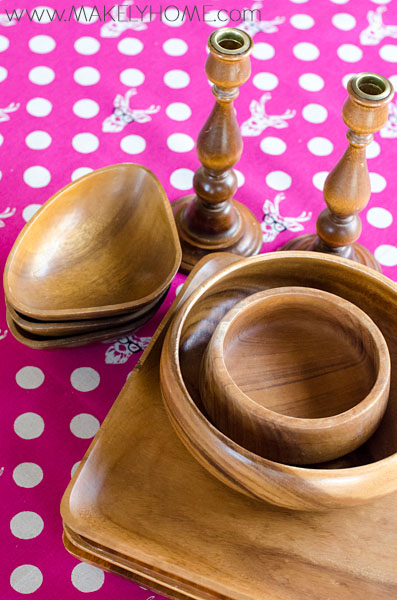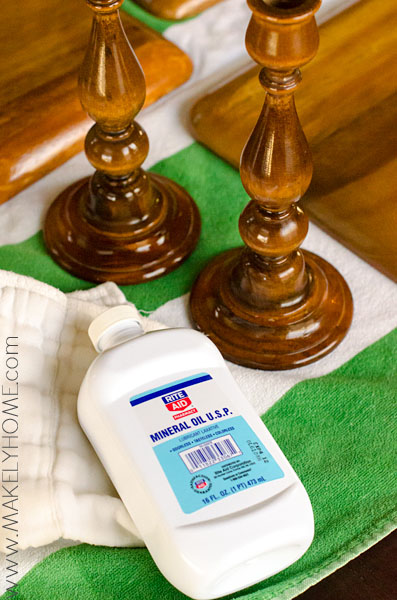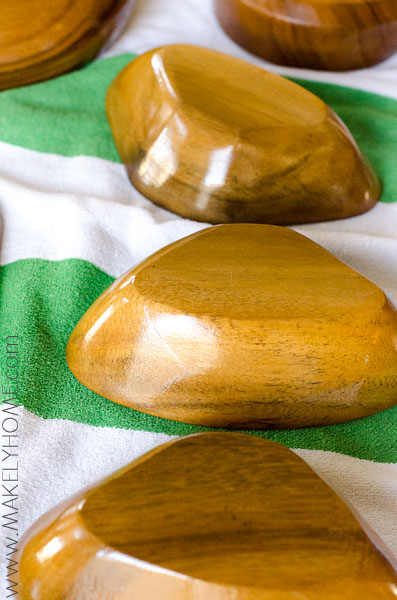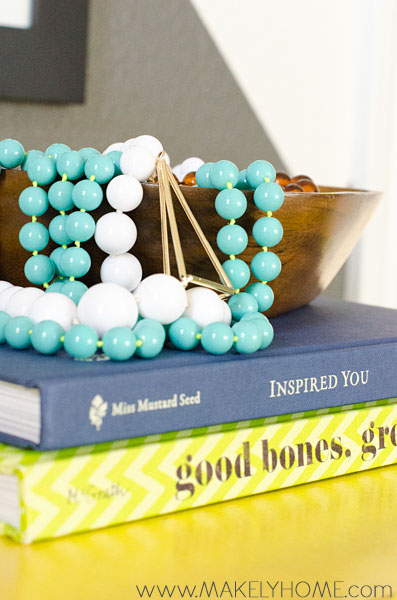I have been collecting wooden bowls and serving pieces form the thrift store like they are going out of style. The good thing is that they’re not! In fact, they are more popular than ever. I’ve found them for as little as $1 per piece, so wooden pieces are a nice way to add a little warmth to your table or to use as displays in other areas around your home.
Because I’ve never owned a wood bowl or platter before, I wasn’t quite sure how to care for them. Obviously, these pieces can’t play my game of Dishwasher Darwinism (i.e. it only survives in my house if it can be washed in the dishwasher), so I had to figure out something easy for my new loves. After a lot of research and product label reading, I figured out the easiest solution to keep the wood looking good. I put together a list of the tips that have worked for me.
How to Care for Wood Bowls and Serving Pieces
1. Clean your wooden pieces with warm water, a mild soap and a soft sponge. Don’t submerge your pieces in water, as it will cause them to crack and swell. Dry them with a dishtowel and then any other moisture dry out by allowing them to air dry overnight.
2. With a soft, lint-free cloth, rub a generous amount of food safe mineral oil on all sides of your wooden pieces. You can pick up the mineral oil at a grocery or drug store – it’s used as an intestinal lubricant. Ahem. There are other oils and products you can buy to oil your wood pieces, but mineral oil was the cheapest and easiest thing to find. My understanding is that the mineral oil won’t harden, go rancid or host microorganisms (yuck!).
3. Put your oiled pieces onto an old towel in a location where you can leave them alone. Allow the oil to soak into your wooden pieces for about 24 hours.
4. Using a clean soft, lint-free cloth, buff any residual oil off of your pieces. You’ll notice that they will have a slightly darker color and a beautiful shine.
5. After each food use (or when they need to be cleaned when used as decor items), wash them as detailed in Step 1. Don’t worry! You won’t need to oil the bowls after each use – only when you feel that they’ve lost their deeper color and shine.
I have big plans for these pieces in a top secret plan to incorporate them onto my dining table in a really fun way. Obviously, I’m avoiding the big project that looms over me, aren’t I?
Do you have any wooden pieces in your tablescape or used as decoration around your home? Please tell us how you care for them!




thanks for the mineral oil tip Lindsay! Pinning it so I don’t forget!
Thanks for the pin, Jessica!
Nice tips.! We inherited a beautiful Bob Stockdale Walnut salad bowl, will your tips be fine for it
I appreciate your advice on cleaning and oiling. We have several pieces from Germany and one that is a vintage find that need to be taken care of!
You’re welcome, Lin!
I just read this one elsewhere, so thought I’d share it, for food-safe items etc.
Mineral oil is great for decorative pieces, but if you need to clean anything that you cut on (say, a wooden cutting board?) use a slice of lemon to clean and disinfect it…it works well, removes those weird smells that cutting boards get, and no ‘flavour’ of mineral oil or anything else afterwards..makes your kitchen smell nice too….
Good advice, Wendi! I rarely use our wooden cutting boards because they scare me, but they are so pretty. I’m going to have to try the lemon trick.
I’ve used mineral oil to keep my wood and bamboo cutting boards in good shape for many years. I’ve never noticed any taste from the mineral oil. I recommend this process. I am looking forward to trying this process with my own wooden bowl collection. I’ve avoided using them because i wasn’t sure how to clean them. Maybe the lemon rub can be used in conjunction with the oil? Love the smell of lemon!
Just had to write this tidbit.
My mother had a wood salad bowl she got in 1939 as a wedding gift. Somehow it broke in two pieces. Dad glued it together with glue they had in those days. Mom continued to use it.
Over the years the break mark disapeared and there was only about an inch left in the bottom that you could see.
I tried to find the bowl when mom died and it was nowhere to be found. I think she got better ones and gave it away.
I have been told that molocules are continually moving and that they had sealed themselves back together. I don’t know what to think of that one. So believe what you want.
Just a cute story.
Lisa
That is awesome! What a great story – thanks for sharing it with me. I wonder if that’s really true? Mysteries of the universe.
These wooden decorative bowls have been showing up more in stores too and I didn’t think of the extra care that would have to go into them before. It doesn’t seem like it would be too difficult and for the warm look and can give a room it would be worth it.
Yeah, it’s not too bad at all!
I am not into wood bowls but your look great…mine would have to have a coat of white paint. lol Dianntha
Ha! I used to be like that, too. Right now, I’m really into natural wood tones mixed with painted stuff.
I make wooden bowls for sale. I think oil finishes are the best. But there are three kinds of oil finish – mineral oil, which you use, it doesn’t go rancid, but never dries, so I’ve found it attracts dust and dirt. Don’t you find that? Then there are vegetable oils, and all of those eventually go rancid in the wood. I use drying oils like Danish oil. They don’t smell when dry, and they are food safe. But all oil finishes eventually lose their shine when they contact water.
I have an article on wood care on my website. Mineral oil is probably the best for something that gets a lot of washing.
Terry
i bought wood platters to put hot saucy food on, whats the best coating so that the wood doesnt absorb the food and is safe for food? thanks!!
Susan, I think any of the oils I mentioned could be used. The mineral oil is non toxic, will wash off, but is easily renewed. Just wipe it on whenever the wood looks dry. Vegetable oil is similar. It has to be washed off to stop it going sour, but you will do that anyway to get food residues off. Danish oil is permanent in the wood, non toxic when dry, but is a bit more trouble to refresh. I like the danish oil, but I would go with the mineral oil for what you want.
The wood will absorb a bit of flavour from the food, but I think you have to accept that if you use wooden utensils. The only way to stop it is with a thick surface film coating like lacquer that seals it completely. But that won’t last long before it breaks down and looks terrible.
So happy to find your post. Thank you for the great cleaning tips!
A friend of mine from college once gifted me a wooden knife that can actually reliable cut food. That made me inspired to one day start using wooden platters and bowls. It’s good to know that using mild soap would be enough to clean such items.
Let me start with I love wood. About 15 years ago I had a custom chopping block and a custom cutting board made to my specs. The cutting board is 1.25″ x 18″ x 13″ and the chopping block is 5″ x 17″ x 27″. Both are end grain maple, walnut and cherry. They are beautiful and well worth their expense. They look as good today as they did 15 years ago. And yes I use them. I wash with a warm soapy cloth, rinse, and dry off as best I can. When necessary, maybe 3 times a year I bathe them in mineral oil. I will saturate all sides. When it soaks in I saturate it again and I keep doing this till it stops absorbing the oil. Then I wipe all excess mineral oil off. This feeds the wood and keeps it from drying out. It also fills all the little pores in the wood so bacteria cannot get in. It does NOT collect dust nor does it impart any mineral oil flavor to foods. Mineral oil is pretty much tasteless.
Super helpful, thanks for the comment!
Very informative and useful tips about wooden platters with excellent presentation. Looking forward to lot more article. Thanks for sharing ideas and such informative article. Find out [https://moonwit.com.au/collections/serving-platters] more about Wooden Platters collection.